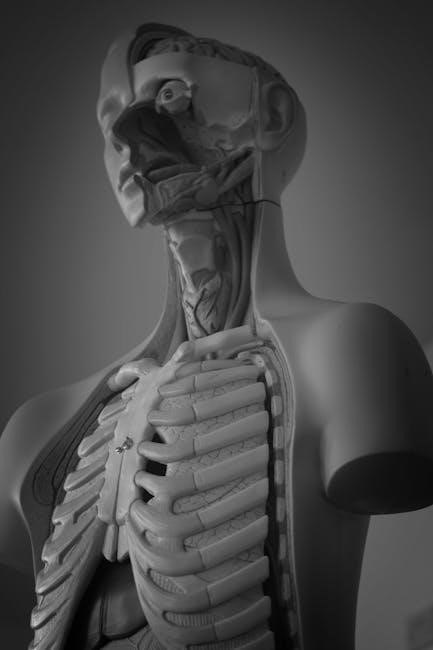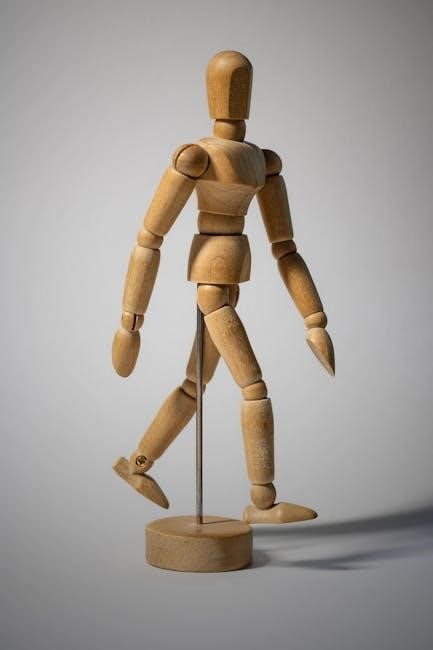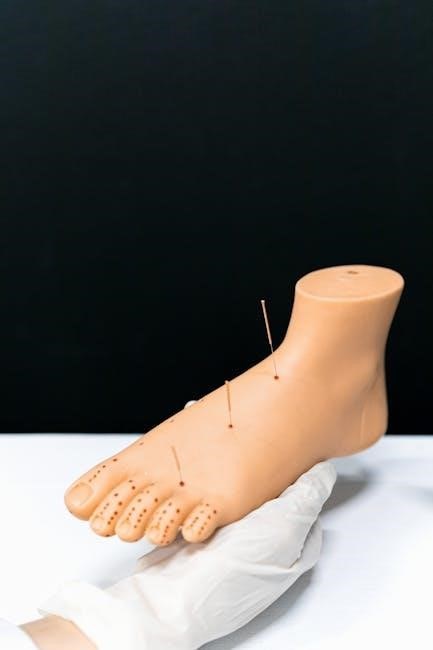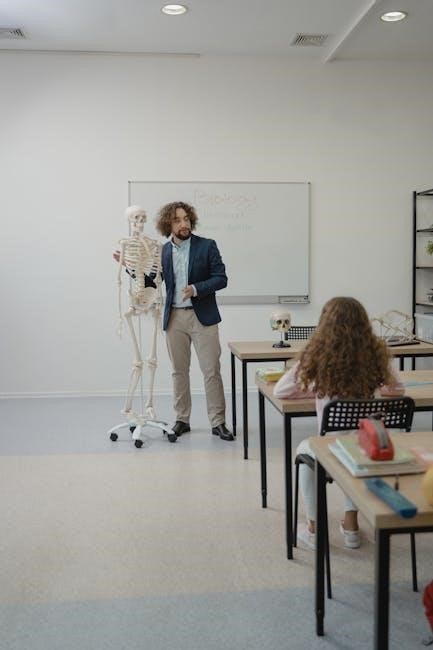The concept of Anatomy Trains, developed by Thomas Myers, explores the body’s fascia as continuous myofascial chains or “trains” that interconnect muscles and structures across the entire body. This revolutionary idea challenges traditional views of isolated muscles, offering insights into movement, injury, and rehabilitation. The Anatomy Trains framework has become foundational in manual therapy, movement education, and somatic practices, providing a holistic understanding of human anatomy and function.
First introduced in 2001, the concept has evolved through updated editions, incorporating new research and visual tools like the Anatomy Trains PDF, which enhances learning and application in clinical and therapeutic settings. By mapping these myofascial connections, practitioners can address dysfunction and pain more effectively, promoting optimal movement and well-being.
1.1 Overview of the Concept
The Anatomy Trains concept, developed by Thomas Myers, introduces a revolutionary approach to understanding human anatomy by viewing the body as interconnected myofascial networks. These “trains” are continuous chains of fascia that link muscles, bones, and other structures, enabling holistic movement patterns. The concept challenges the traditional view of muscles as isolated entities, instead emphasizing the interconnectedness of the body’s fascial system. This framework provides insights into how movement, posture, and injury are influenced by these fascial connections. By mapping these lines, practitioners can address dysfunction and pain more effectively. The Anatomy Trains PDF and related resources offer detailed visual guides, making the concept accessible for therapists, educators, and students. This approach has become a cornerstone in fields like manual therapy, rehabilitation, and movement education.
1.2 Historical Background and Development
The Anatomy Trains concept was first introduced by Thomas Myers in his groundbreaking book, Anatomy Trains: Myofascial Meridians for Manual and Movement Therapists, published in 2001. Building on the work of earlier anatomists and fascia researchers, Myers proposed a new paradigm that viewed the body as a network of interconnected fascial lines. This idea revolutionized the understanding of human movement and anatomy, offering a more integrated perspective. Over the years, the concept has evolved through revised editions, incorporating new scientific findings and enhanced visual tools, such as the Anatomy Trains PDF, which provides detailed illustrations and animations. These updates have further solidified the concept’s relevance in fields like physical therapy, athletic training, and somatic education, making it a foundational resource for practitioners worldwide.

The Concept of Fascial Lines
Fascial lines are interconnected networks of myofascial chains that span the body, enabling coordinated movement. They form the foundation of Anatomy Trains, aiding in therapy and movement analysis. The Anatomy Trains PDF provides detailed visual guides and applications for practitioners.
2.1 Myofascial Chains and Their Role in Movement
Myofascial chains are interconnected networks of muscles, tendons, and fascia that form the basis of movement patterns. These chains, as outlined in the Anatomy Trains PDF, play a crucial role in facilitating coordinated and efficient movement by allowing forces to be distributed across multiple joints and muscles. They enable the body to function as a unified system rather than isolated parts, enhancing both stability and mobility. Understanding these chains is essential for therapists and practitioners, as imbalances or restrictions within them can lead to dysfunction or injury. By addressing these chains, interventions can restore optimal movement and reduce pain, making them a cornerstone of modern therapeutic approaches. The detailed illustrations and descriptions in the Anatomy Trains PDF provide a comprehensive guide for identifying and working with these myofascial networks.
2.2 Thomas Myers’ Vision of the Body as a Connected System
Thomas Myers’ groundbreaking vision reimagines the body as an interconnected system, where fascia plays a central role in linking muscles, bones, and organs into a cohesive whole. His concept of Anatomy Trains maps these connections as continuous myofascial chains, challenging the traditional view of isolated muscle groups. Myers’ work emphasizes the importance of understanding the body’s fascial network, which allows for efficient movement, distributes forces, and maintains posture. This holistic perspective has revolutionized fields such as manual therapy, movement education, and rehabilitation, offering new approaches to addressing pain and dysfunction. The Anatomy Trains PDF serves as a key resource, detailing these interconnected pathways and their implications for practice. Myers’ vision continues to evolve with updated research, further enhancing its relevance in modern therapeutic applications.

Applications in Rehabilitation and Therapy
The Anatomy Trains concept is widely applied in rehabilitation and therapy to address pain management, injury prevention, and postural correction, enhancing recovery through a fascia-centered approach.
3.1 Manual Therapy and Structural Integration
Manual therapy and structural integration techniques leverage the Anatomy Trains concept to release fascial restrictions, optimizing the body’s interconnected web. By targeting myofascial chains, practitioners restore balance and fluidity, addressing tension patterns that underlie pain and dysfunction. This approach, detailed in the Anatomy Trains PDF, emphasizes holistic treatment, ensuring lasting structural changes. The integration of these methods fosters a deeper understanding of the body’s fascial network, enabling therapists to address the root causes of discomfort effectively.
3.2 Movement Therapy and Athletic Training
Movement therapy and athletic training benefit greatly from the Anatomy Trains concept, as it provides a framework for understanding how fascial lines influence movement patterns. By identifying and addressing imbalances in these myofascial chains, practitioners can enhance performance, prevent injuries, and improve overall athleticism. The Anatomy Trains PDF offers detailed insights into how specific lines, such as the Superficial Back Line or Spiral Line, contribute to movement efficiency. This knowledge enables trainers to design targeted exercises that strengthen weak areas and restore optimal mobility. Integrating these principles into training programs fosters a more holistic approach to physical conditioning, ensuring that athletes achieve their full potential while maintaining structural integrity and reducing the risk of injury.
3.3 Somatic Therapy and Pain Management
The Anatomy Trains concept has become a cornerstone in somatic therapy and pain management, offering a comprehensive understanding of how fascial connections influence chronic pain and movement restrictions. By mapping the myofascial lines, therapists can identify patterns of tension and dysfunction that contribute to pain. Techniques such as fascial stretching and manual therapy target these lines to restore balance and mobility. The Anatomy Trains PDF provides detailed diagrams and explanations, enabling practitioners to visualize and address these connections effectively. This approach not only alleviates pain but also enhances overall bodily awareness, empowering clients to engage in mindful movement and self-care practices. Integrating Anatomy Trains into somatic therapy fosters a holistic, client-centered approach to pain management and long-term well-being.

Key Fascial Lines Identified by Myers

Thomas Myers identified several key fascial lines, including the Superficial Back Line, Front Line, Lateral Line, Spiral Line, Arm Lines, Functional Line, and Deep Front Line. These interconnected myofascial pathways play a crucial role in movement and posture, as detailed in the Anatomy Trains PDF, offering a mapped understanding of the body’s fascial network.
4.1 The Superficial Back Line (SBL)
The Superficial Back Line (SBL) is one of the primary fascial lines identified by Thomas Myers. It is a continuous myofascial chain that runs from the plantar surface of the feet, up the posterior aspect of the legs and torso, and over the head to the brow bone. This line plays a crucial role in maintaining upright posture and facilitating movements such as walking, sitting, and standing. The SBL integrates key structures like the plantar fascia, Achilles tendon, hamstrings, sacrotuberous ligament, and scalp fascia. Dysfunction in this line can lead to postural imbalances and movement restrictions. The Anatomy Trains PDF provides detailed illustrations and descriptions of the SBL, aiding therapists in identifying and addressing fascial tensions along this pathway to restore optimal movement patterns and reduce pain.
4.2 The Front Line (FL)
The Front Line (FL) is a fascial continuity that runs along the anterior surface of the body, playing a key role in movements like flexion and forward propulsion. It begins on the top of the feet, ascends the shins, thighs, and torso, and extends through the neck to the head. This line includes structures such as the tibialis anterior, quadriceps, rectus abdominis, and sternocleidomastoid muscles. The FL is essential for activities such as walking, running, and reaching. The Anatomy Trains PDF highlights how imbalances in this line can contribute to issues like lower back pain or limited hip flexion. Understanding and addressing tensions in the FL can enhance mobility and reduce discomfort, making it a vital focus in therapeutic and training practices.

4.3 The Lateral Line (LL)
The Lateral Line (LL) is a fascial network running along the body’s lateral surface, from the peroneal muscles of the lower leg up to the neck. It includes structures like the IT band, obliques, and scalenes, playing a key role in balance, side bending, and rotational movements. This line is essential for maintaining upright posture and lateral stability. The LL is also involved in movements like walking and running, where it helps in stabilizing the body during weight transfer. The Anatomy Trains PDF details how this line integrates with other fascial networks, emphasizing its importance in overall movement efficiency. Imbalances in the LL can lead to issues like IT band syndrome or poor lateral stability, making it a critical focus for therapists and movement professionals to address through targeted exercises and manual therapy.

4.4 The Spiral Line (SL)
The Spiral Line (SL) is a diagonal fascial network that wraps around the body, connecting the right foot to the left shoulder and vice versa. It plays a crucial role in movements involving rotation, diagonal reach, and gait. This line includes structures like the peroneals, IT band, TFL, obliques, and rhomboids, enabling activities such as walking, running, and throwing. The SL is essential for generating power and maintaining balance during dynamic movements. Its dysfunction can lead to issues like uneven gait, poor posture, or limited rotational mobility. The Anatomy Trains PDF provides detailed illustrations and descriptions of the SL, helping practitioners understand its role in movement and rehabilitation; By addressing imbalances in the SL, therapists can restore fluid motion and enhance overall movement efficiency.
4.5 The Arm Lines (AL)
The Arm Lines (AL) are fascial networks connecting the arms to the trunk, playing a key role in movements like pushing, pulling, and rotational actions. These lines integrate the upper body’s myofascial connections, enabling coordinated movement between the shoulders, chest, and arms. The AL includes structures such as the latissimus dorsi, pectoralis major, and biceps brachii, which work together to stabilize and propel the body during activities. Understanding the AL is crucial for addressing shoulder and elbow injuries, as imbalances in these lines can lead to pain and limited mobility. The Anatomy Trains PDF provides detailed illustrations of the AL, offering insights into their functional role in both therapy and athletic training. By targeting these lines, practitioners can restore balance and enhance upper body performance.
4.6 The Functional Line (FL)
The Functional Line (FL) is one of the key fascial networks identified by Thomas Myers, playing a crucial role in functional movements that involve the legs, pelvis, and arms. This line acts as a diagonal myofascial connection, enabling the transmission of forces across the body during activities like walking, running, and throwing. The FL includes structures such as the biceps femoris, latissimus dorsi, and teres major, which work together to stabilize and facilitate dynamic movements. Understanding the FL is essential for addressing injuries related to sports and repetitive strain, as imbalances in this line can disrupt coordination and lead to inefficiency. The Anatomy Trains PDF provides detailed insights into the FL, offering practical applications for therapists and movement professionals to enhance performance and restore balance. By focusing on the FL, practitioners can improve functional movement patterns and reduce the risk of injury.
4.7 The Deep Front Line (DFL)
The Deep Front Line (DFL) is a critical fascial network that plays a central role in the body’s core stability, posture, and internal support. Identified by Thomas Myers, the DFL consists of structures such as the psoas major, quadratus lumborum, iliacus, and diaphragm, which form a continuous myofascial chain from the pelvis to the head. This line is essential for maintaining proper spinal alignment, facilitating breathing, and enabling efficient movement patterns. Dysfunctions in the DFL can lead to issues like lower back pain, respiratory inefficiency, and postural imbalances. The Anatomy Trains PDF provides detailed insights into the DFL, offering therapists and practitioners valuable tools for assessing and addressing these deep fascial connections. Understanding the DFL is vital for restoring core integrity and promoting overall bodily harmony.

Advances in Research and Editions
Recent editions of Anatomy Trains integrate new scientific discoveries, enhancing understanding of myofascial connections. Updated artwork and digital resources, like videos, enrich the learning experience for therapists.
5.1 Updates in the Second and Third Editions
The second edition of Anatomy Trains introduced significant revisions, incorporating updated scientific findings and enhanced visual aids. New digital media, including videos and animations, were added to deepen understanding. The third edition further refined these updates, with corrections from clinical practice and preliminary research insights. Both editions expanded the online resources, offering interactive tools for therapists and educators. These updates ensure the Anatomy Trains remains a cutting-edge resource for understanding myofascial connections and their role in movement and therapy. The inclusion of new visual aids and digital content enhances the practical application of the concepts in clinical settings.
5.2 Integration of New Scientific Findings
The integration of new scientific findings has significantly enriched the Anatomy Trains concept, particularly in understanding fascial connections and their role in movement. Recent research highlights the interconnectedness of the neural net, vascular system, and extracellular fibrous web, which collectively shape the body’s structure and function. These findings emphasize the importance of fascial continuity and its implications for rehabilitation and therapy. Digital resources, such as the Anatomy Trains PDF, now include updated visuals and animations that illustrate these connections in detail. Additionally, podcasts and video clips provide practical insights into clinical applications, making the framework more accessible to therapists and educators. This ongoing integration of science ensures the Anatomy Trains remains a dynamic and evidence-based approach to understanding human anatomy.

Educational Resources and Tools
The Anatomy Trains PDF and digital media offer comprehensive insights into myofascial meridians, enhanced with visuals and animations. Charts, diagrams, and online tools provide practical resources for therapists and educators.
6.1 Anatomy Trains PDF and Digital Media
The Anatomy Trains PDF is a detailed resource that outlines the myofascial connections conceptualized by Thomas Myers. Available for download, it includes enhanced artwork, animations, and video clips that illustrate the fascial lines and their role in movement and structure. Digital media accompanying the PDF provides interactive learning tools, such as 3D models and instructional videos, which aid in understanding complex anatomical relationships. These resources are particularly valuable for manual and movement therapists, offering a visual and practical guide to applying the Anatomy Trains concept in clinical practice. The integration of multimedia elements makes the PDF a comprehensive and accessible tool for both education and professional development.

6.2 Charts, Diagrams, and Visual Aids
Charts, diagrams, and visual aids are essential components of the Anatomy Trains educational resources, complementing the Anatomy Trains PDF. These tools provide clear, detailed illustrations of the myofascial lines, such as the Superficial Back Line and the Spiral Line, helping practitioners visualize fascial connections. High-quality anatomical diagrams and posture analysis charts enable professionals to assess and address structural imbalances effectively. The visual aids are designed to enhance understanding of fascial anatomy and its role in movement patterns and pain management. They are widely used in therapeutic and educational settings, offering a practical means to apply the Anatomy Trains concept in real-world applications. These resources are continually updated with new scientific findings, ensuring they remain a cutting-edge tool for therapists and educators alike.
The concept of Anatomy Trains, as detailed in the Anatomy Trains PDF, revolutionizes the understanding of human anatomy and movement by emphasizing the interconnectedness of fascial networks. This framework, developed by Thomas Myers, has profoundly influenced fields such as manual therapy, rehabilitation, and athletic training. By mapping myofascial chains, it provides a holistic approach to addressing injuries, improving mobility, and enhancing overall well-being. The integration of visual aids, updated research, and digital resources like the Anatomy Trains PDF ensures that this knowledge remains accessible and practical for professionals and learners alike. As the field continues to evolve, the Anatomy Trains concept remains a cornerstone for understanding the body as a unified, interconnected system.
